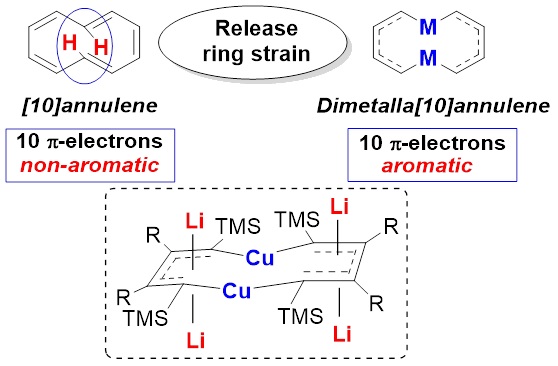研究室工作进展 Jan. 21st, 2016
Aromatic Dicupra[10]annulenes
Junnian Wei, Yongliang Zhang, Yue Chi, Liang Liu, Wen-Xiong Zhang, and Zhenfeng Xi*
J. Am. Chem. Soc. 2016, 138, 60−63.

BACKGROUND: The chemistry of metal-containing aromatics (metalla-aromatics) has long been a fundamental and fascinating topic. However, the synthesis of macrocyclic metalla-aromatics with different metals still remains a great challenge. On the other hand, annulenes, which usually have a general formula C2nH2n, are classic cyclic conjugated systems. However, the [10]annulene having 10 π-electrons is non-aromatic, due to the steric hindrance of the two internal hydrogens. To release the steric hindrance of [10]annulene, we considered to replace the two internal C-H fragments with transition metals. Thus, if each of the two metals could offer one electron to form delocalized π-bonds, then the dimetalla[10]annulene could be aromatic. We have been working on the synthetic applications of multiply substituted 1,4-dilithio 1,3-butadienes (dilithio reagents for short). Recently, we found that appropriate dilithio reagents could react with low-valent transition metals, offering aromatic dilithio-metalloles (Wei, J.; Zhang, W.-X.; Xi, Z. Angew. Chem., Int. Ed. 2015, 54, 5999; Wei, J.; Zhang, Y.; Zhang, W.-X.; Xi, Z. Angew. Chem., Int. Ed. 2015, 54, 9986.), in which the dilithio reagents behaved as non-innocent ligands. Inspired by the novel behavior of dilithio reagents, we envisioned that macrocyclic metalla-aromatics could be obtained by annulating two or more dilithio reagents with suitable transition metals. This work reports the synthesis, characterization, and theoretic study of macrocyclic metalla-aromatics, dicupra[10]annulenes.
ABSTRACT: Metal-containing aromatic systems (metalla-aromatics) are unique and important both experimentally and theoretically. Among metalla-aromatics, 6-membered metallabenzenes and metallabenzynes have attracted much attention in recent years. However reports on their superior homologues are rare. In this work, the first series of aromatic dicupra[10]annulenes were isolated from the reaction of dilithio reagents and copper salts. Single-crystal X-ray structural analysis revealed dicupra[10]annulenes with averaged bond lengths. 7Li NMR spectra and theoretical calculations revealed a considerable aromatic character. XPS data suggested that the oxidation state of Cu atom in dicupra[10]annulenes was more likely to be Cu(I), indicating that the dilithio moieties in dicupra[10]annulenes were participated as non-innocent ligands. This work demonstrates a novel approach to construct macrocyclic metalla-aromatics.
亮点介绍
利用双锂试剂的氧化还原活性合成芳香性金属杂环
在已知的氧化还原反应中,碳负离子如常见的有机锂试剂可能作为还原剂而失去电子,但是不作为氧化剂进一步得到电子。本课题组魏俊年同学利用我们自己发展的双锂试剂及其协同效应,与低价过渡金属配合物如Ni(cod)2和[RhCl(cod)]2反应,合成了相应的芳香性金属杂环戊二烯衍生物(for Ni,see: Angew. Chem. Int. Ed. 2015, 54, 5999-6002; for Rh, see: Angew. Chem. Int. Ed. 2015, 54, 9986-9990.)。在该反应中,双锂试剂的丁二烯基双碳负离子共轭体系的反键轨道与低价过渡金属的d轨道中的一对电子产生“协同效应”,使富电荷的丁二烯骨架继续获得电子,成功构建了具有芳香性的金属杂环戊二烯衍生物。该研究打破了传统所认为的碳负离子不能够继续获得电子的认知,为共轭体系碳负离子化学的进一步发展和应用提供了一个全新的思路。单晶结构和谱学表征包括锂谱结合理论计算证实了所生成的金属杂环戊二烯衍生物具有显著的芳香性。X-射线光电子能谱显示过渡金属的氧化态显著上升(Ni近似+2价,Rh近似+3价)。由于双锂试剂中碳负离子与丁二烯骨架的协同效应,其LUMO轨道能级相对于1,3-丁二烯显著降低,故一些过渡金属的d轨道电子可离域至双锂试剂的π*轨道,完成芳香性金属杂环的构建。双锂试剂在该反应中可视为一类特殊的non-innocent ligand或者redox-active ligand,发生了氧化还原反应。
在以上工作的基础上,魏俊年同学和他的小伙伴们秉承本实验室“协同效应”理念和“深新信”原则,继续深入探索了该类反应的理论意义、普适性和应用。本工作“芳香性双铜杂轮烯”为最新研究成果之一。
芳香性概念及芳香性体系在自然界和自然科学中极为重要。虽然芳香性的定义一直存在争议,没有定论,但是芳香性的概念、理论和新的芳香体系一直层出不穷。【推荐科普中文阅读:芳香性概念的新发展,严兢、宋寅、彭德高、李珉,《大学化学》,2007, 22(1),33-40.】芳香性金属有机化合物化学具有重要意义。近年来我国厦门大学夏海平教授和香港科技大学贾国成教授在芳香性金属杂环研究领域取得了一系列开创性成果。但是,由于该类化合物的合成方法有限,已知的该类化合物无论是结构多样性和金属多样性都很有限。芳香性金属有机化合物的合成方法和后续的结构、成键模式、和性质研究仍然存在巨大挑战。另一个方面,轮烯(一般通式:C2nH2n)是一大类具有共轭结构的环状有机化合物。其中,最有代表性的是环丁二烯(4π,反芳香性)和苯环(6π,芳香性)。而[10]轮烯(C10H10)虽然具有共轭的10个π电子,但是不具有芳香性。结构决定性质。这是由于两个反式双键碳上的氢原子处于环内,它们相互排斥导致环被扭曲以致环不在同一平面上。我们考虑,如果这两个CH基团能够分别被金属原子所取代,并且这两个金属原子的轨道还可以参与其它有机共轭部分的离域化,就有可能在避免相互排斥作用的同时,实现大环芳香性金属杂环的合成,即芳香性双金属杂轮烯。受到我们前期双锂试剂与低价金属新颖反应性的启发,我们研究了易于生成链状结构的有机铜化合物的合成,得到了芳香性双铜杂轮烯。通过单晶结构,谱学表征和理论计算证实了该类化合物具有显著的芳香性。XPS显示Cu近似+1价。
该系列工作也是本课题组双金属有机合成试剂化学的新展开。
